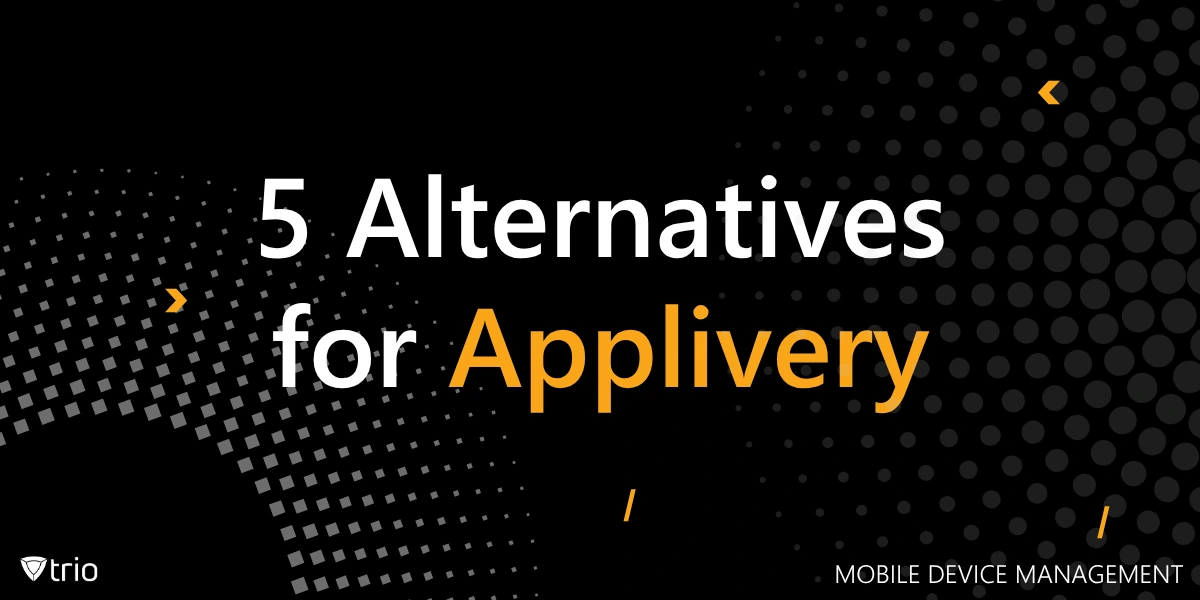As organizations increasingly rely on mobile devices to support their operations, effective mobile device management (MDM) has become a cornerstone of IT strategy. While Applivery has built its reputation as a strong app distribution and lightweight MDM tool, many businesses in 2025 are realizing its limitations. App distribution alone no longer covers the complexity of modern IT needs; today’s businesses require advanced automation, cross-platform coverage, airtight security, and compliance features to support remote and hybrid teams.
That’s why IT leaders are looking for Applivery alternatives that can deliver broader device management and future-ready capabilities. In this guide, we’ll explore five top contenders—Trio, Jamf Pro, Hexnode UEM, Miradore, and Kandji—and show you how they stack up against Applivery.
1. Trio – Unified MDM for Diverse Device Ecosystems
Best for SMBs and mid-market organizations managing mixed devices
Trio is a modern mobile device management (MDM) and unified endpoint management (UEM) platform designed for simplicity and security. Unlike Applivery, which is primarily app-distribution focused, Trio offers comprehensive cross-platform support—covering macOS, iOS, Android, and Windows. This makes it ideal for organizations with hybrid device fleets.
Key Strengths of Trio:
- Automated onboarding/offboarding: Zero-touch deployment with QR codes and bulk provisioning.
- Compliance-first design: Enforces HIPAA, GDPR, and SOC 2 policies automatically.
- Advanced endpoint security: Remote lock/wipe, Lost Mode, and real-time threat detection.
- Identity integrations: Works with Okta, Microsoft 365, and Google Workspace for stronger access control.
- Scalable pricing: SMB-friendly with free trials and predictable per-device costs.
Pros:
- Full cross-platform coverage
- Enterprise-grade security features
- Simple, intuitive dashboard
- Cost-effective for SMBs
Cons:
- Smaller brand presence compared to Jamf or Hexnode
- Some advanced policies require initial IT configuration

2. Jamf Pro – Comprehensive Apple Device Management
Best for Apple-only environments
Jamf Pro remains the gold standard for Apple ecosystem management. If your organization runs exclusively on macOS, iOS, iPadOS, and tvOS, Jamf offers the deepest level of integration and control.
Key Strengths of Jamf:
- Zero-touch deployment: Out-of-the-box setup via Apple Business Manager.
- Patch automation: Keeps macOS/iOS devices always updated.
- Inventory tracking: Rich device analytics for IT visibility.
- Native Apple service integration: Works seamlessly with Apple School Manager, AppleCare, and iCloud.
Pros:
- Tailor-made for Apple products
- Smooth user experience for employees
- Best-in-class security for Apple endpoints
Cons:
- No support for Windows or Android
- Higher pricing than SMB-friendly tools
3. Hexnode UEM – Unified Endpoint Management Across Platforms
Best for enterprises with diverse, global device fleets
Hexnode UEM is a multi-platform powerhouse that supports iOS, Android, macOS, Windows, and even Linux devices. Its single-pane-of-glass dashboard helps IT teams manage thousands of devices globally.
Key Strengths of Hexnode:
- Broad OS coverage: Covers desktops, mobile devices, and rugged endpoints.
- Granular policies: From kiosk lockdown to app whitelisting.
- Remote configuration: Push policies, apps, and restrictions in real time.
- Flexible deployment: Available as both cloud and on-premises solution.
Pros:
- Full UEM coverage across OSs
- Enterprise-grade controls
- Scales well for large organizations
Cons:
- Steeper learning curve for SMB IT admins
- Reporting features could be more detailed
4. Miradore – Cloud-Based MDM for Small to Mid-Sized Businesses
Best for SMBs on a budget
Miradore is a cloud-based MDM that appeals to SMBs without large IT teams. Its freemium model makes it especially attractive for small companies wanting a no-cost entry point.
Key Strengths of Miradore:
- Cloud-native design: Easy setup with no servers required.
- Multi-OS support: Works with Windows, Android, iOS, and macOS.
- Real-time monitoring: Tracks device compliance and usage.
- Budget flexibility: Free plan available; paid tiers unlock advanced features.
Pros:
- Very easy to deploy
- Free tier for testing and small teams
- Accessible UI for non-technical admins
Cons:
- Limited advanced automation
- Less suited for enterprise compliance needs
5. Kandji – Apple Device Management with a Security Focus
Best for Apple-focused enterprises prioritizing security
Kandji is a newer player, but its automation-first philosophy has made it popular among Apple-first businesses.
Key Strengths of Kandji:
- Automated Device Management engine: Enforces policies, apps, and OS updates with no manual work.
- Compliance templates: Over 150 pre-built remediation scripts.
- Deep integrations: Connects with Okta, Azure AD, and Apple Business Manager.
- Security by default: Built to align with SOC 2, ISO 27001, and CIS benchmarks.
Pros:
- Highly automated compliance enforcement
- Apple-centric design with great UX
- Strong integrations with identity providers
Cons:
- Premium pricing tier
- Apple-only support
What sets Kandji apart is its “Automated Device Management” engine. This no-code workflow automates tasks like enforcing compliance policies, application delivery, and handling OS updates. Its library of over 150 pre-built scripts and remediation actions ensures devices stay configured and secure without manual intervention. This level of automation can significantly reduce the workload for IT teams and improve operational consistency.
Why Companies Are Moving Beyond App Distribution-Only Tools
Applivery shines at app distribution, but modern IT requires more than app deployment. The landscape in 2025 demands:
- Stronger endpoint security to fight advanced mobile malware.
- Cross-platform control as workforces use mixed devices.
- Automated compliance for GDPR, HIPAA, SOC 2.
- BYOD privacy protection to separate corporate and personal data.
Simply put, app distribution is only one piece of MDM. Businesses that stay locked into app-only platforms risk compliance failures, higher IT workloads, and data breaches.
Key Evaluation Criteria for Applivery Alternatives
When shortlisting alternatives, IT leaders should compare vendors based on:
| Criteria | Why It Matters | Example Vendor Strength |
|---|---|---|
| Cross-Platform Support | Mixed fleets need centralized control | Trio, Hexnode |
| Automation | Reduces manual IT overhead | Kandji, Trio |
| Security & Compliance | Essential for regulated industries | Hexnode, Trio |
| Ease of Use | SMB IT teams need simplicity | Miradore, Trio |
| Pricing | Budgets vary widely | Miradore (budget), Kandji (premium) |
Future of MDM – Trends to Watch in 2025 and Beyond
- AI-driven policy enforcement → Detect risky device behavior and auto-remediate.
- Zero-trust integration → MDM + IAM = stronger security posture.
- IoT device management → Beyond phones/laptops to AR headsets, scanners, and wearables.
- Privacy-first BYOD → Data partitioning without invading user privacy.
- Lifecycle sustainability → Track device usage and carbon impact.
Choosing an Applivery alternative today means preparing for tomorrow’s device landscape.
Applivery vs Competitors at a Glance
| Feature | Applivery | Trio | Jamf Pro | Hexnode | Miradore | Kandji |
|---|---|---|---|---|---|---|
| Cross-Platform Support | Limited | ✅ | ❌ (Apple only) | ✅ | ✅ | ❌ (Apple only) |
| Automation | Limited | ✅ | ✅ | ✅ | ❌ | ✅ |
| Security & Compliance | Basic | ✅ | ✅ | ✅ | ❌ | ✅ |
| Ease of Use | Moderate | ✅ | ✅ | Medium | ✅ | ✅ |
| Pricing | Mid | SMB-friendly | Premium | Mid-high | Free/Paid | Premium |
Conclusion
While Applivery has made a name for itself in app distribution and lightweight MDM, it no longer addresses the security, compliance, and automation needs of modern IT teams. The best Applivery alternatives—Trio, Jamf Pro, Hexnode, Miradore, and Kandji—each bring unique strengths to the table.
- Trio: Best all-around for SMBs and mixed fleets
- Jamf Pro: Apple-only excellence
- Hexnode: Enterprise-scale UEM
- Miradore: Budget-conscious SMBs
- Kandji: Apple-focused automation and compliance
Trio stands out for SMBs and growing companies that need cross-platform support, strong security, and automation at a fair price.
Trio gives you everything you need to manage and secure your organization’s devices—across Android, iOS, macOS, and Windows—with intuitive tools, automation, and powerful security features. Sign up today for a free trial or explore a free demo to see Trio in action and discover why so many businesses are switching from legacy MDM platforms.
Frequently Asked Questions
Because Applivery focuses heavily on app distribution, leaving gaps in security, automation, and compliance. Modern IT needs broader MDM features.
Trio and Miradore are the strongest SMB picks thanks to simplicity, automation, and flexible pricing.
Jamf Pro and Kandji dominate here with deep Apple integrations.
Trio offers cross-platform MDM, advanced automation, real-time security, and compliance enforcement—things Applivery lacks.
Yes. Trio, Hexnode, and Kandji offer built-in compliance frameworks and reporting tools.
- Miradore: free and low-cost tiers
- Trio: SMB-friendly, transparent pricing
- Kandji/Jamf: premium enterprise pricing
Get Ahead of the Curve
Every organization today needs a solution to automate time-consuming tasks and strengthen security.
Without the right tools, manual processes drain resources and leave gaps in protection. Trio MDM is designed to solve this problem, automating key tasks, boosting security, and ensuring compliance with ease.
Don't let inefficiencies hold you back. Learn how Trio MDM can revolutionize your IT operations or request a free trial today!





